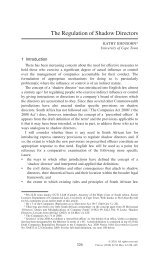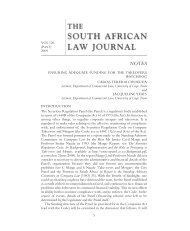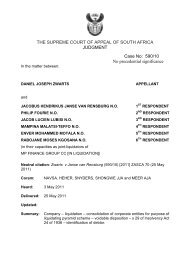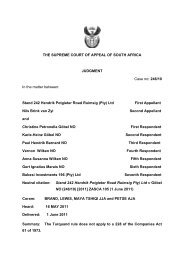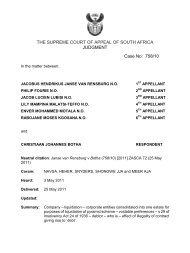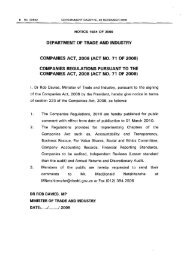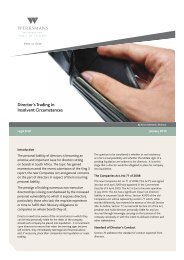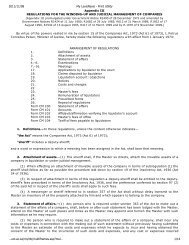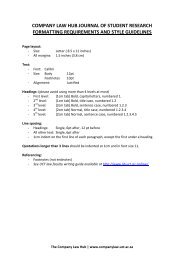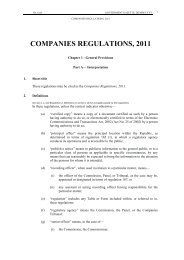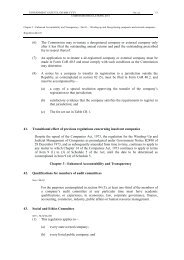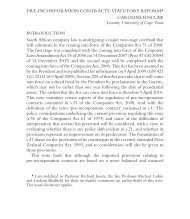Blue Square Advisory Services (Pty) Ltd v Mandingoane and Another
Blue Square Advisory Services (Pty) Ltd v Mandingoane and Another
Blue Square Advisory Services (Pty) Ltd v Mandingoane and Another
You also want an ePaper? Increase the reach of your titles
YUMPU automatically turns print PDFs into web optimized ePapers that Google loves.
(1) REPORTABLE: YES / NO<br />
(2) OF INTEREST TO OTHER JUDGES: YES/NO<br />
(3) REVISED.<br />
REPUBLIC OF SOUTH AFRICA<br />
……………………..<br />
DATE<br />
………………………...<br />
SIGNATURE<br />
SOUTH GAUTENG HIGH COURT, JOHANNESBURG<br />
CASE NO: 01082/2011<br />
In the matter between:<br />
BLUE SQUARE ADVISORY SERVICES (PTY) LTD Applicant<br />
<strong>and</strong><br />
MADINGOANE POGISO<br />
First Respondent<br />
SEPENG WINSTON<br />
Second Respondent<br />
JUDGMENT<br />
PETER AJ<br />
[1] The issue in this application is whether or not the first <strong>and</strong> second<br />
respondents were lawfully removed as directors of the applicant company by a<br />
valid members’ resolution at a general meeting of members convened on<br />
26 November 2009 in terms of the provisions of section 220 of the Companies<br />
Act, 61 of 1973 (“the 1973 Act”).<br />
[2] On 22 November 2005 one Johannes Hendrik Louw, whom I shall<br />
hereinafter refer to as “Louw”, the first respondent <strong>and</strong> the applicant company,<br />
represented by Louw, executed a written document entitled “Heads of<br />
Agreement”. This document served to record the intentions <strong>and</strong> agreements of<br />
the three parties thereto. Recorded therein was an envisaged transaction<br />
between Louw, the first respondent <strong>and</strong> the applicant, that the first respondent<br />
would acquire shares <strong>and</strong> claims in the applicant to the extent of 50%. The<br />
transaction was subject to Louw successfully buying back 50% of the shares<br />
<strong>and</strong> claims from one Naicker. The transaction date was to be effective 1
Page 2<br />
November 2005. Transaction documents mentioned therein were to include<br />
inter alia a new shareholders’ agreement, a purchase <strong>and</strong> sale agreement,<br />
contracts of employment for the executives, <strong>and</strong> rules <strong>and</strong> procedures for the<br />
staff of the applicant. An independent party was to conduct the valuation of<br />
the business of the applicant at 1 November 2005 <strong>and</strong> the first respondent was<br />
entitled to conduct a detailed due diligence on the business of the applicant.<br />
The first respondent was appointed an employee of the applicant company. It<br />
was envisaged that a more formal contract of employment would be drafted in<br />
due course but that in the interim the heads of agreement was to govern the<br />
working relationship between the applicant <strong>and</strong> its executives.<br />
[3] At the time of the conclusion of the agreement, the register of<br />
members of the applicant company reflected that 50% of the issued shares<br />
therein were owned by the “Johan en Mercia Louw Familie Trust<br />
(IT4819/99)” (“the family trust”). The other 50% was held by Naicker. Both<br />
the family trust <strong>and</strong> Naicker appear to have acquired their respective shares<br />
from the first registered member <strong>and</strong> subscriber to the memor<strong>and</strong>um, one<br />
Linda Hall. Letters of Authority were issued by the Master of the High Court<br />
on 30 October 2002 in terms of the provisions of section 6(1) of the Trust<br />
Property Control Act, 1988. The Letters of Authority certified that Louw,<br />
Mercia Pritch Louw to whom I shall hereinafter refer to as “Mrs Louw”, <strong>and</strong><br />
one Karen Coetzer, as the nominee of Quadro Executive Estate Planning (<strong>Pty</strong>)<br />
Limited, were authorised to act as trustees of the family trust.<br />
[4] On 14 February 2006 Louw <strong>and</strong> the applicant company <strong>and</strong> the<br />
trustees of the family trust entered into a written agreement in terms whereof<br />
the trustees purchased from Naicker, Naicker’s 50% of the issued shares in the<br />
applicant for the sum of R150 000,00. On 16 February 2006 the first<br />
respondent was appointed a director of the applicant. Thereafter <strong>and</strong> in<br />
April 2007, the second respondent was employed by the applicant <strong>and</strong><br />
appointed a director of the applicant in August 2007.
Page 3<br />
[5] The principal commercial rationale for the involvement of the first<br />
respondent, <strong>and</strong> later the second respondent, in the affairs of the applicant was<br />
to give the applicant black economic empowerment (“BEE”) status <strong>and</strong> to<br />
assist the applicant in securing contracts with municipal local authorities. The<br />
later involvement of the second respondent in the affairs of the applicant was<br />
with a view ultimately that the first <strong>and</strong> second respondents collectively would<br />
hold two-thirds of the equity in the applicant company <strong>and</strong> further enhance its<br />
BEE credentials.<br />
[6] Thereafter the relationship between Louw <strong>and</strong> the first <strong>and</strong> second<br />
respondents deteriorated. Although this much is common cause, there are<br />
conflicting disputes, allegations <strong>and</strong> counter-allegations of surreptitious<br />
competition with the business of the company, maladministration <strong>and</strong> a<br />
struggle for control in which Louw purportedly procured the appointment of<br />
additional directors, the first <strong>and</strong> second respondents dismissed Louw <strong>and</strong><br />
Louw suspended the first <strong>and</strong> second respondents. It is not necessary for<br />
present purposes to catalogue or detail the full extent of the disputes. Suffice<br />
it to say that what transpired in the applicant company echoes the Western<br />
Schism that divided Europe at the end of the 14 th <strong>and</strong> the beginning of the 15 th<br />
Centuries with rival papacies of Avignon <strong>and</strong> Rome furiously denouncing <strong>and</strong><br />
excommunicating each other.<br />
[7] Matters came to a head when on 22 October 2009 Mrs Louw<br />
purported to lodge with the applicant company a notice in terms of section<br />
220(2) of the 1973 Act <strong>and</strong> to requisition a special general meeting of the<br />
company on 26 November 2009 for the purposes of removing the first <strong>and</strong><br />
second respondents as directors of the company. On 26 November 2009<br />
Louw purported to pass a resolution on behalf of the members of the company<br />
removing the first <strong>and</strong> second respondents as directors of the applicant. On<br />
that date, the members’ register of the applicant reflected as the name of its<br />
only member “Johan en Mercia Louw Familie Trust (IT 4819/99)”.
Page 4<br />
[8] Mr Moorcroft, who appeared for the applicant, borrowing the title of<br />
a song of the American musician Kris Kristofferson, submitted to me that I<br />
need not make a determination of “who’s to bless <strong>and</strong> who’s to blame”.<br />
Notwithst<strong>and</strong>ing the myriad of disputes, allegations <strong>and</strong> counter-allegations, I<br />
need concern myself only whether or not the resolution removing the first <strong>and</strong><br />
second respondents was properly passed.<br />
[9] The version of the applicant is that after the conclusion of the heads<br />
of agreement with the first respondent, there was much negotiation about the<br />
first respondent purchasing shares <strong>and</strong> negotiation about the second<br />
respondent later acquiring shares but no agreement in this regard. No<br />
purchase price has ever been paid by either the first or second respondents for<br />
the shares. When matters came to a head, Mrs Louw <strong>and</strong> Louw, acting on<br />
behalf of the registered member, properly convened a meeting in terms of<br />
section 220 of the 1973 Act <strong>and</strong> passed an effective resolution removing the<br />
first <strong>and</strong> second respondents as directors.<br />
The factual disputes<br />
[10] Mr Limberis, who appeared for the respondents, submitted to me that<br />
this application should be dismissed by reason of material disputes of fact. In<br />
this regard, the respondents allege three oral agreements. The first oral<br />
agreement is one alleged to have been concluded at about the time of the heads<br />
of agreement between the first respondent, the company represented by Louw<br />
<strong>and</strong> the family trust (“the November 2005 agreement”). It was allegedly<br />
agreed that, if Louw was unable to acquire Naicker’s shares or if the first<br />
respondent or his nominee did not obtain ownership of the shares for any<br />
reason, the first respondent would remain a director <strong>and</strong> employee of the<br />
applicant company <strong>and</strong> he would be paid, in addition to his salary, one half of<br />
the net profits made by the company on all contracts procured after 1<br />
November 2005.
Page 5<br />
[11] The second oral agreement alleged by the respondents was by<br />
agreement entered into after 14 February 2006, the date of the written<br />
agreement of sale of Naicker’s shares (“the February 2006 agreement”). In<br />
terms of the February 2006 agreement, the respondents allege that the first<br />
respondent agreed with Louw, acting on behalf of the family trust, that the<br />
first respondent would hold 50,1% of the shares in the company for which the<br />
first respondent was required to pay R150 000,00 to the family trust, being the<br />
fair market value of the shares as at 1 November 2005. At the time of this<br />
agreement, the respondents allege that Louw suggested that the first<br />
respondent form a trust to hold the shares. The first respondent agreed to<br />
consider the formation of his own trust but alleged that it was agreed that in<br />
the interim the family trust was to hold the shares as his nominee until such<br />
time as he instructed the family trust to transfer the shares to him or his<br />
nominee. The first respondent alleges that it was clearly understood <strong>and</strong><br />
agreed that he would be entitled to the dividends <strong>and</strong> voting rights which<br />
attached to the shares, or put differently, these rights were to be exercised by<br />
the family trust at his instruction until otherwise agreed.<br />
[12] The third oral agreement is alleged to have been concluded during or<br />
about April 2007 (“the April 2007 agreement”). The respondents allege that at<br />
that time they were negotiating with a view to transfer one-third of the shares<br />
in the company to the second respondent, half of the second respondent’s<br />
shares to come from the first respondent <strong>and</strong> the other half from the family<br />
trust or to create a new structure in which the shares would so be held. The<br />
respondents allege that it was agreed between the applicant, represented by<br />
both Louw <strong>and</strong> the first respondent, the first respondent <strong>and</strong> the second<br />
respondent that until the shares were transferred to the first <strong>and</strong> second<br />
respondents, the company would pay the first <strong>and</strong> second respondents one<br />
third each of the net profits made by the company on contracts, in addition to<br />
their salaries <strong>and</strong> that they would both be employed by the company <strong>and</strong> be<br />
directors of the company for so long as the contracts continued to be<br />
performed.
Page 6<br />
[13] In essence therefore, the oral agreements alleged by the respondents<br />
attack the resolution on two bases. The first is directed at underlying<br />
ownership <strong>and</strong> voting rights. This challenge is that notwithst<strong>and</strong>ing any<br />
registration in the members’ register, the first respondent beneficially owned<br />
50.1% of the shares <strong>and</strong> the voting rights attaching thereto had to be exercised<br />
by the family trust in accordance with his instructions. The voting that Louw<br />
purported to do on behalf of the family trust was in breach of the February<br />
2006 agreement <strong>and</strong> the resolution was thus invalid. The second basis of<br />
attack is that there was an agreement of security of tenure of the respondent’s<br />
directors; the passing of the resolution was in violation thereof <strong>and</strong> unlawful<br />
<strong>and</strong> the resolution thus invalid.<br />
The applicant’s challenge to the factual disputes<br />
[14] The applicant challenged the efficacy of the February 2006<br />
agreement on the basis that any purchase of shares had to be in writing. The<br />
applicant denied the existence or conclusion of the oral agreements.<br />
[15] In regard to the requirement of writing, the applicant alleged that the<br />
heads of agreement document required any subsequent purchase <strong>and</strong><br />
shareholders’ agreement to be in writing. Mr Moorcroft relied on the case of<br />
Goldblatt v Freemantle 1920 AD 123. At pages 128 to 129 of the report, the<br />
following is said by Innes CJ:<br />
“Subject to certain exceptions, mostly statutory, any contract may be<br />
verbally entered into; writing is not essential to contractual validity.<br />
And if during negotiations mention is made of a written document, the<br />
Court will assume the object was merely to afford facility of proof of<br />
the verbal agreement, unless it is clear that the parties intended that<br />
the writing should embody the contract. (Grotius 3.14.20 etc.). At the<br />
same time it is always open for the parties to agree that a contract<br />
shall be a written one (see Voet 5.1.73. V. Leeuwen 4.2; sec. 2,<br />
Deckers’s note), <strong>and</strong> in that case there will be no binding obligation
Page 7<br />
until the terms have been reduced to writing <strong>and</strong> signed.<br />
question is in each case one of construction.”<br />
The<br />
[16] I am unable to agree with Mr Moorcroft’s submission. This is so<br />
principally for two reasons. First, as a matter of construction, it appears to me<br />
that the heads of agreement were executed to serve the purpose of recording<br />
what was to be a binding agreement until later superceded. The heads of<br />
agreement did no more than record that the parties envisaged that a more<br />
formal agreement, one in writing, would in due course be executed. The<br />
document properly construed does not prescribe that the parties agreed that the<br />
future agreement relating to the purchase of the shares had to be in writing in<br />
order to be valid. Secondly, even if the agreement could so be construed as<br />
prescribing a necessary formality, the formality provision itself could be<br />
altered by agreement between the parties. As Mr Limberis, rightly pointed out<br />
in the context of the law relating to non-variation clauses which prescribe the<br />
formalities of writing <strong>and</strong> signature, the formality provision itself will be<br />
capable of variation unless entrenched, SA Sentrale Ko-op Graan Maatskappy<br />
Bpk v Shifren & Andere 1964 (4) SA 760 (A).<br />
[17] The next attack by Mr Moorcroft on the alleged oral agreement, was<br />
that I should find factually that there was no basis for such an agreement <strong>and</strong><br />
reject the allegations of the respondents in this regard as being far fetched or<br />
clearly untenable. The basis of this attack was that it was common cause that<br />
on 26 November 2009 the first <strong>and</strong> second respondents appeared at the<br />
meeting with a somewhat lengthy letter drafted by their attorney in which a<br />
number of challenges to the validity of the meeting <strong>and</strong> proposed resolution<br />
were made. Nowhere in the letter were the oral agreements recorded.<br />
However the affidavits disclosed a claim for preference points made in the bid<br />
of which Louw was the author. In the bid a claim for points was made on the<br />
basis of a representation that 50.1% of the applicant was owned by an<br />
historically disadvantaged individual, thereby making reference to the first<br />
respondent. The same document records the first respondent as owning 50.1%<br />
of the applicant’s business with a note that the applicant was in the process of
Page 8<br />
improving the BEE/HDI status to at least 60%. I do not intend to express any<br />
view on the strengths or merits of the factual dispute other than to say that this<br />
is not a factual dispute which is properly determined on affidavit in motion<br />
proceedings.<br />
[18] Accordingly it is necessary to consider the lawfulness of the<br />
resolution in the light of the version of the respondents.<br />
The statutory framework<br />
[19] In order to determine whether or not the agreements, alleged by the<br />
respondents, render the resolution to remove the respondents as directors<br />
invalid or ineffective, regard must first be had to the provisions of section 220<br />
of the 1973 Act, the relevant parts of which read as follows:<br />
“220 (1) (a) A company may, notwithst<strong>and</strong>ing anything in its<br />
memor<strong>and</strong>um or articles or in any agreement between it <strong>and</strong> any<br />
director, by resolution remove a director before the expiration of his<br />
period of office.<br />
. . .<br />
(2) Special notice shall be lodged with the company of any proposed<br />
resolution to remove a director under this section or to appoint any<br />
person in the stead of a director so removed at the meeting at which he<br />
is removed, <strong>and</strong>, on receipt of notice of such a proposed resolution, the<br />
company shall forthwith deliver a copy thereof to the director<br />
concerned who shall, whether or not he is a member of the company,<br />
be entitled to be heard on the proposed resolution at the meeting.<br />
[20] There are thus two important features to be noted from the provisions<br />
of section 220. First that the power granted by a company to remove a<br />
director overrides anything in its memor<strong>and</strong>um or articles <strong>and</strong> overrides any<br />
agreement between it <strong>and</strong> any director. Secondly, the power is exercised by<br />
resolution of which special notice is required to be lodged <strong>and</strong> given.<br />
[21] Relevant to the passing of a resolution at a meeting in terms of the<br />
provisions of section 220 of the 1973 Act are other provisions of the 1973 Act,<br />
to which regard must be had. These are sections 181, 184, 186, 188, 189, 190,
Page 9<br />
193 <strong>and</strong> 197. The relevant provisions of these sections (with emphasis added)<br />
are set out below:<br />
“181(1) The directors of a company shall, notwithst<strong>and</strong>ing anything in<br />
its articles, on the requisition of-<br />
(a) one hundred members of the company or of members holding<br />
at the date of the lodging of the requisition not less than one-twentieth<br />
of such of the capital of the company as at the date of the lodgement<br />
carries the right of voting at general meetings of the company . . .<br />
. . . issue a notice to members convening a general meeting of the<br />
company. . .<br />
184 In the case of a company having only one member, such member<br />
present in person or by proxy shall be deemed to constitute a meeting.<br />
186(1) (a) Unless the articles of a company provide for a longer period<br />
of notice, the annual general meeting or a general meeting called for<br />
the purpose of passing a special resolution may be called by not less<br />
than twenty-one clear days' notice in writing <strong>and</strong> any other general<br />
meeting may be called by not less than fourteen clear days' notice in<br />
writing.<br />
. . .<br />
(3) No resolution of which special notice is required to be given in<br />
terms of any provision of this Act shall have effect unless notice of the<br />
intention to move it has been given to the company not less than<br />
twenty-eight days before the meeting at which it is moved . . .<br />
188(1) A company or other body corporate may, by resolution of its<br />
directors or other governing body, authorize any person to act as its<br />
representative at any meeting of any company of which it is a member<br />
or at any meeting of any class of members of that company.<br />
. . .<br />
(3) A person authorized as aforesaid shall be entitled to exercise on<br />
behalf of the company or other body corporate which he represents, the<br />
same powers as that company or body corporate could have exercised<br />
if it were an individual shareholder, debenture-holder or creditor of the<br />
company in relation to which such person has been authorized to act.<br />
189(1) Any member of a company entitled to attend <strong>and</strong> vote at a<br />
meeting of the company, or where the articles of a company limited by<br />
guarantee so provide, any member of such company, shall be entitled
Page 10<br />
to appoint another person (whether a member or not) as his proxy to<br />
attend, speak, <strong>and</strong> vote in his stead at any meeting of the company<br />
. . .<br />
190 Unless the articles of a company provide for a greater number of<br />
members entitled to vote to constitute a quorum at meetings of a<br />
company, the quorum for such meetings shall be-<br />
. . .<br />
(b) in the case of a private company, not being a private company<br />
having one member, two members entitled to vote, present in person or<br />
by proxy or, if a member is a body corporate, represented; <strong>and</strong><br />
(c) in the case of a wholly-owned subsidiary company, the<br />
representative of the holding company.<br />
193(1) Subject to the provisions of sections 194 <strong>and</strong> 195 <strong>and</strong> to the<br />
exceptions stated in section 196, every member of a company having a<br />
share capital shall have a right to vote at meetings of that company in<br />
respect of each share held by him.<br />
197(1) Any person present <strong>and</strong> entitled to vote, on a show of h<strong>and</strong>s, as<br />
a member or as a proxy or as a representative of a body corporate at<br />
any meeting of the company shall on a show of h<strong>and</strong>s have only one<br />
vote, irrespective of the number of shares he holds or represents.<br />
(2) On a poll at any meeting of a company, any member (including a<br />
body corporate) or his proxy shall be entitled to exercise all his voting<br />
rights as determined in accordance with the provisions of this Act, but<br />
shall not be obliged to use all his votes or cast all the votes he uses in<br />
the same way.”<br />
[22] From the above provisions it is clear that members of the company<br />
are critical role players. The directors of a company are required to convene a<br />
general meeting of the company upon a requisition of members of the<br />
company, section 181(1)(a). A quorum at the meeting is determined by the<br />
presence of a member either present in person or by proxy, sections 184 <strong>and</strong><br />
190. Where a company or body corporate is a member of a company, it may<br />
by resolution authorise a person to act as its representative, section 188(1).<br />
Such representative exercises the power of the company or body corporate<br />
member as if such company or body corporate were an individual, section<br />
188(3). Members may appoint a proxy, section 189. Subject to exceptions not
Page 11<br />
relevant in the present case, members of a company have the right to vote at<br />
meetings in respect of each share held by such members, section 193. These<br />
exceptions relate to preference shares, section 194, different classes of shares,<br />
carrying different voting rights, section 195 <strong>and</strong> provisions relating to voting<br />
rights of shares in existence at the commencement of the 1973 Act, section<br />
196. Voting rights are exercised by members either personally present or<br />
present through a proxy or a company’s representative of a body corporate,<br />
section 197. Special notice of 28 days must be given to members for a<br />
resolution in terms of section 220, section 186(3) <strong>and</strong> section 220(2).<br />
[23] In relation to members of the company, sections 103, 104 <strong>and</strong> 109 of<br />
the 1973 Act provide as follows:<br />
“103 (1) The subscribers of the memor<strong>and</strong>um of a company shall be<br />
deemed to have agreed to become members of a company upon its<br />
incorporation, <strong>and</strong> shall forthwith be entered as members in its register<br />
of members.<br />
(2) Every other person who agrees to become a member of a company<br />
<strong>and</strong> whose name is entered in its register of members, shall be a<br />
member of the company.<br />
(3) A company shall, subject to the provisions of its articles, enter in<br />
the register as a member, nomine officii, of the company, the name of<br />
any person who submits proof of his appointment as the executor,<br />
administrator, trustee, curator or guardian in respect of the estate of a<br />
deceased member of the company or of a member whose estate has<br />
been sequestrated or of a member who is otherwise under disability or<br />
as the liquidator of any body corporate in the course of being wound<br />
up which is a member of the company, <strong>and</strong> any person whose name<br />
has been so entered in the register shall for the purposes of this Act be<br />
deemed to be a member of the company.<br />
(4) Subject to the provisions of section 213 (1) (b), the bearer of a<br />
share warrant may, if the articles of the company so provide, be<br />
deemed to be a member of the company within the meaning of this<br />
Act, either for all purposes or for such purposes as may be specified in<br />
the articles.<br />
104 A company shall not be bound to see to the execution of any trust,<br />
whether express, implied or constructive, in respect of any share.<br />
109 The register of members of a company shall be prima facie<br />
evidence of any matters directed or authorised to be entered therein by<br />
this Act.”
Page 12<br />
[24] Before considering the legal efficacy of the agreements alleged by the<br />
respondents, it is necessary to make some observations about trusts.<br />
Trusts<br />
[25] The 5 th edition of Honoré’s South African Law of Trusts, 2002,<br />
(“Honoré”), describes a trust as “a legal institution in which a person, the<br />
trustee subject to public supervision, holds or administers property separately<br />
from his or her own, for the benefit of another person or persons or for the<br />
furtherance of a charitable or other purpose”. This description has been<br />
quoted with approval most recently in Lupacchini <strong>and</strong> <strong>Another</strong> NO v Minister<br />
of Safety <strong>and</strong> Security 2010 (6) SA 457 (SCA), as a description of a trust as a<br />
“legal relationship of a special kind”.<br />
[26] The statutory definition of a trust in terms of the Trust Property<br />
Control Act, 57 of 1988 is as follows:<br />
“'trust' means the arrangement through which the ownership in<br />
property of one person is by virtue of a trust instrument made over or<br />
bequeathed-<br />
(a) to another person, the trustee, in whole or in part, to be<br />
administered or disposed of according to the provisions of the trust<br />
instrument for the benefit of the person or class of persons designated<br />
in the trust instrument or for the achievement of the object stated in the<br />
trust instrument; or<br />
(b) to the beneficiaries designated in the trust instrument, which<br />
property is placed under the control of another person, the trustee, to be<br />
administered or disposed of according to the provisions of the trust<br />
instrument for the benefit of the person or class of persons designated<br />
in the trust instrument or for the achievement of the object stated in the<br />
trust instrument,<br />
but does not include the case where the property of another is to be<br />
administered by any person as executor, tutor or curator in terms of the<br />
provisions of the Administration of Estates Act, 1965 (Act 66 of<br />
1965)”<br />
[27] The English textbook Hanbury <strong>and</strong> Martin, Modern Equity, 18 ed<br />
2009 p 49 describes a trust as follows:
Page 13<br />
“A trust is a relationship recognised by equity which arises when<br />
property is vested in (a person or) persons called the trustees, which<br />
those trustees are obliged to hold for the benefit of other persons<br />
called cestuis que trust or beneficiaries.”<br />
[28] This description is given after it is noted that many attempts have<br />
been made to define a trust but none of them have been wholly successful.<br />
The author notes that it is more useful to describe than to define a trust <strong>and</strong><br />
then to distinguish it from related concepts.<br />
[29] Typically a trust has a creator. Where the trust is created during the<br />
lifetime of the creator it is referred to as an inter vivos trust. The creator of the<br />
trust is variously referred to as the donor, founder or settlor. A testamentary<br />
trust may be created by will through a testator. In Honoré, the institution of<br />
trust is compared with other legal institutions such as contracts, agency,<br />
partnership <strong>and</strong> others. A trust is thus a matrix of multilateral rights <strong>and</strong><br />
obligations involving a person who creates the trust, at least one person who<br />
accepts the obligations as trustee, generally including a person who is a<br />
beneficiary <strong>and</strong> the public roles of the Master <strong>and</strong> the High Court. At its heart,<br />
whether described as an institution, an arrangement or a relationship, a trust is<br />
a legal relationship governing the ownership or control of assets <strong>and</strong> their<br />
enjoyment.<br />
[30] A trust is not a person <strong>and</strong> does not have legal personality. In<br />
Commissioner for Inl<strong>and</strong> Revenue v Friedman <strong>and</strong> Others NNO 1993 (1) SA<br />
353 (A) at 370E-I the following is said by Joubert JA:<br />
“Is a trust a legal persona? According to the Anglo-American law of<br />
trusts a trust has no legal personality. P W Duff Personality in Roman Private<br />
Law Cambridge University Press (1938) at 206:<br />
'Maitl<strong>and</strong> showed [Collected Papers vol 3 (1911) 321-404)] that by<br />
vesting property in trustees, rather than in corporations or associations,<br />
English lawyers evaded many questions that have caused difficulty abroad.'<br />
See R W Ryan in his unpublished Cambridge doctoral thesis entitled 'The<br />
Reception of the Trust in the Civil Law' (1959) at 11: 'A trust is certainly not a<br />
legal person'. The position is the same in our law of trusts. See Commissioner
Page 14<br />
for Inl<strong>and</strong> Revenue v MacNeillie's Estate 1961 (3) SA 833 (A) at 840G-H:<br />
'Neither our authorities nor our Courts have recognised it as a persona or<br />
entity. It is trite law that the assets <strong>and</strong> liabilities in a trust vest in the trustee.'<br />
Consult also Braun v Blann <strong>and</strong> Botha NNO <strong>and</strong> <strong>Another</strong> 1984 (2) SA 850 (A)<br />
at 859E-H:<br />
'In its strictly technical sense the trust is a legal institution sui generis<br />
. . . .The trustee is the owner of the trust property for purposes of<br />
administration of the trust but qua trustee he has no beneficial interest therein.'<br />
It is clear therefore that a trust is not an incorporated company. Nor is a trust a<br />
body of persons unincorporate whose common funds are the collective<br />
property of all its members. There is also no basis for a submission that<br />
because the statutory definition of 'person' in s 1 of the 1962 Act was extended<br />
to include a deceased estate, it should by analogy be further extended to<br />
include a trust. The conclusion is inescapable that a trust is not a 'person'<br />
within the meaning of that word in the 1962 Act”.<br />
[31] Often in commercial usage, reference is made to a trust as if it were a<br />
legal person <strong>and</strong> in a sense other than a matrix of legal relationships. Perhaps<br />
it is that people making such commercial usage are unaware of the legal nature<br />
of a trust <strong>and</strong> unaware that a trust is not a legal person like a company which<br />
exists by reason of a legal fiction. Be that as it may, courts have not been<br />
astute to find such reference meaningless but rather give such reference a<br />
meaning in its context. Thus where a testator made a bequest of the residue of<br />
his estate to two named trusts which were family trusts which he had created<br />
shortly before the execution of his will, it was held to be a valid bequest to the<br />
trustees in their capacities as such of the trusts therein mentioned, Kohlberg v<br />
Burnett NO & Others 1986 (3) SA 12 (A). Similarly where in a suretyship a<br />
trust was described as the principal debtor, this was interpreted to be a<br />
description of the trustees of the trust in their capacities as such <strong>and</strong> the<br />
suretyship was valid in that it complied with the provisions of section 6 of the<br />
General Laws Amendment Act 50 of 1956; extrinsic evidence was permissible<br />
to identify the trustees, BOE Bank <strong>Ltd</strong> (formerly NBS Bol<strong>and</strong> Bank <strong>Ltd</strong>) v<br />
Trustee, Knox Property Trust [1999] 1 All SA 425 (D).<br />
[32] It is also possible to refer to a trust in a sense that refers neither to the<br />
matrix of legal relationships nor the trustees in their capacity as such, but
Page 15<br />
rather the trust estate as an accumulation of assets <strong>and</strong> liabilities. Thus a trust,<br />
in the sense of a trust estate has been held to be “a debtor in the usual sense of<br />
the word” for the purposes of section 2 of the Insolvency Act of 1936 <strong>and</strong> thus<br />
capable of being sequestrated, Magnum Financial Holdings (<strong>Pty</strong>) <strong>Ltd</strong> (in<br />
liquidation) v Summerly <strong>and</strong> <strong>Another</strong> NNO 1984 (1) SA 160 (W). In the<br />
context of an accumulation of assets <strong>and</strong> liabilities, although not a legal<br />
person, a trust estate has been described as a separate entity, L<strong>and</strong> <strong>and</strong><br />
Agricultural Bank of South Africa v Parker <strong>and</strong> Others 2005 (2) SA 77 (SCA)<br />
at 83G-84H. In this sense, the assets, held or controlled in trust <strong>and</strong> the<br />
liabilities, incurred by the trustees, satisfaction of which may be had by<br />
recourse to the trust assets, are a separate entity just like a deceased estate or<br />
the joint estate of people married in community of property performing juristic<br />
acts with regard to such estate in terms of the provisions of section 15 of the<br />
Matrimonial Property Act, 88 of 1984.<br />
[33] The observations made thus far in respect of trusts are in respect of<br />
trusts <strong>and</strong> trustees in the narrow sense. There is a wider sense in the use of the<br />
word “trustee” as it describes someone who is bound to hold or administer on<br />
behalf of another or for some impersonal object <strong>and</strong> not for his or her own<br />
benefit, Honoré pp3-4. In Engl<strong>and</strong> the notion of a constructive trust, one<br />
which arises by operation of law, is employed to impose obligations through<br />
the application of equitable doctrines in factual situations which give rise to<br />
remedies in the South African Roman Dutch legal system through the<br />
application of principles of contract, delict <strong>and</strong> unjust enrichment, Honoré<br />
pp131-136.<br />
The efficacy of the alleged agreements<br />
[34] In the February 2006 agreement, the first respondent asserts<br />
ownership of 50.1% of the shares of the company. It is possible to own shares<br />
without being registered as the member. This is possible where shares are<br />
purchased <strong>and</strong> acquired <strong>and</strong> as a matter of property, ownership is transferred<br />
by way of cession without registration in the members’ register. Ownership
Page 16<br />
may pass on conclusion of the cession without delivery of share certificates or<br />
transfer forms, Botha v Fick 1995 (2) SA 750 (A). The register of members is<br />
prima facie proof of ownership of the shares, section 109 of the 1973 Act.<br />
The court is entitled to go behind the register to ascertain the identity of the<br />
true owner. Thus where a registered member sold his shares <strong>and</strong> became<br />
insolvent after ownership had passed to the purchaser but before registration<br />
had taken place in the name of the purchaser, the court could go behind the<br />
register <strong>and</strong> make a determination that notwithst<strong>and</strong>ing registration in the<br />
name of the insolvent seller, the shares were not assets in the insolvent seller’s<br />
estate, McGregor’s Trustees v Silberbauer (1891-1892) 9 SC 36. Similarly<br />
upon the death of one of two registered members both of whom held shares as<br />
trustees, without any personal beneficial interest therein, for an overseas bank,<br />
the court could go behind the register to declare that no part of the shares<br />
registered in their names belonged to the deceased estate. No stamp duty was<br />
payable in respect thereof to the master, R<strong>and</strong>fontein Estates <strong>Ltd</strong> v The Master<br />
1909 TS 978.<br />
[35] The concept of a nominee as an agent to hold shares in his name <strong>and</strong><br />
be the registered member on behalf of a nominator or principal, has been<br />
recognised as a convenient <strong>and</strong> accepted practice. The principal whose name<br />
does not appear on the register is usually described as “the beneficial owner”<br />
which is not juristically speaking within the South African legal system,<br />
Oakl<strong>and</strong> Nominees (<strong>Pty</strong>) <strong>Ltd</strong> v Gelria Mining & Investment Co (<strong>Pty</strong>) <strong>Ltd</strong> 1976<br />
(1) SA 441 (A) at 453. This is so because the concept of a “beneficial owner”<br />
is a concept of equitable ownership as distinct from legal ownership applicable<br />
in English trust law but inappropriate to characterise the personal rights of a<br />
beneficiary in a trust or a principal in a principal agent relationship in South<br />
African law. This is a common practice <strong>and</strong> well understood commercially<br />
although the employment of trust terminology is done perhaps in the wide<br />
sense. The courts have gone behind the register to recognise the beneficial<br />
owner’s interest to enforce the rights of the beneficial owner visa a vis the<br />
nominee <strong>and</strong> to compel the nominee to deliver to the beneficial owner the<br />
share certificates together with the necessary transfer documents, St<strong>and</strong>ard
Page 17<br />
Bank of South Africa <strong>Ltd</strong> <strong>and</strong> <strong>Another</strong> v Ocean Commodities Inc <strong>and</strong> Others<br />
1983 (1) SA 276 (A). Where shares have been sold <strong>and</strong> ceded by a registered<br />
member, the court could go behind the register to identify the purchaser as the<br />
true owner of the shares <strong>and</strong> rectify the register to reflect the purchaser as the<br />
registered member in circumstances where the seller refused to sign the<br />
necessary transfer forms to facilitate registration in the purchaser’s name,<br />
Botha v Fick (referred to above). In an appropriate case it is open for a court<br />
to go behind the register to identify a beneficial owner for the purposes of<br />
determining who controls that company, as a matter of fact, notwithst<strong>and</strong>ing a<br />
nominee registered as the owner where such factual control is relevant as in<br />
admiralty proceedings, MV Heavy Metal: Belfry Marine <strong>Ltd</strong> v Palm Base<br />
Maritime SDN BHD 1999 (3) SA 1083 (A) at 1106H-I. Where a registered<br />
member had sold his shares but registration has not yet taken place in the<br />
register in the purchaser’s name, it is permissible for the court to go behind the<br />
register to ascertain the true nature of the seller member’s interest in order to<br />
determine whether or not it is just <strong>and</strong> equitable to wind up a company at the<br />
instance of the member who is no longer the owner of the shares in respect of<br />
which he is registered as the member, Kalil v Decotex (<strong>Pty</strong>) <strong>Ltd</strong> <strong>and</strong> <strong>Another</strong><br />
1988 (1) SA 943 (A).<br />
[36] In none of the reported cases has it ever been held permissible for the<br />
court to go behind the members’ register in order to confer membership status<br />
on a beneficial owner, in the absence of an application for rectification of the<br />
register. In fact in Lourenco <strong>and</strong> Others v Ferela (<strong>Pty</strong>) <strong>Ltd</strong> <strong>and</strong> Others (No 1)<br />
1998 (3) SA 281 (T), Southwood J declined to go behind the register, at the<br />
instance of an alleged true owner of shares whose ownership had not been<br />
registered in the register of members, in order to give the true owner the status<br />
of member which was a necessary prerequisite to an application for relief from<br />
oppression in terms of section 252 of the 1973 Act.<br />
[37] In matters such as the status of its member vis a vis the company, it<br />
has long been the policy of the law that the company should concern itself<br />
only with the registered owner of the shares, St<strong>and</strong>ard Bank of South Africa
Page 18<br />
<strong>Ltd</strong> <strong>and</strong> <strong>Another</strong> v Ocean Commodities Inc <strong>and</strong> Others 1983 (1) SA 276 (A) at<br />
289A-B. This policy is embodied in the provisions of section 104 of the 1973<br />
Act. In Pender v Lushington (1877) 6 Ch 70, the articles of association of the<br />
company provided that every member was to have one vote for every<br />
complete number of ten shares held with a voting limit that no shareholder<br />
shall be entitled to more than 100 votes. A beneficial shareholder interested in<br />
more than 1000 shares, with the object of increasing its voting powers,<br />
arranged for its shares to be held through nominees so as to be able to cast 649<br />
votes. The company rejected the votes <strong>and</strong> in proceedings by a member to<br />
restrain the rejection of votes, Jessel MR held the following at 77-78:<br />
“It appears to me that it is plain from the reading of these articles<br />
alone that the articles meant to refer to a registered member, but I think it is<br />
made, if possible, plainer – though I doubt whether it could be made plainer<br />
when you come to consider that it would not be possible to work the company<br />
in any other way, for how else could the company hold meetings or dem<strong>and</strong> a<br />
poll, or have the votes taken by scrutineers? – but if possible it is made plainer<br />
by the 19th article, which says: “The executors <strong>and</strong> administrators of a<br />
deceased member shall be the only persons recognised by the company as<br />
having any title to his share,” <strong>and</strong> also provides that “the company shall not be<br />
affected by notice of any trust.” And the 30th section of the Companies Act,<br />
1862 says: “No notice of any trust express, implied, or constructive, shall be<br />
entered on the register, or be receivable by the Registrar in the case of<br />
companies registered under this Act <strong>and</strong> registered in Engl<strong>and</strong> or Irel<strong>and</strong>.” It<br />
comes, therefore to this, that the register of shareholders, on which there can<br />
be no notice of trust, furnishing the only means of ascertaining whether you<br />
have a lawful meeting or a lawful dem<strong>and</strong> for a poll, or of enabling the<br />
scrutiny as to strike out votes.<br />
The result appears to be manifest, that the company has no right<br />
whatever to enter into the question of the beneficial ownership of the shares.<br />
Any such suggestion is quite inadmissible, <strong>and</strong> therefore it is clear that the<br />
chairman had no right to enquire who was the beneficial owner of the shares,<br />
<strong>and</strong> the votes in question ought to have been admitted as good votes<br />
independent of any enquiry as to whether the parties tendering them were or<br />
were not, <strong>and</strong> to what extent, trustees for other persons beneficially entitles to<br />
the shares.”<br />
[38] In Société Générale de Paris <strong>and</strong> <strong>Another</strong> v The Tramways Union<br />
Company, <strong>Ltd</strong>, <strong>and</strong> Others (1884-1885) 14 QB 424 (CA) Lindley, LJ said the<br />
following at pages 451-452:
Page 19<br />
“But if shares in companies registered under the Companies Act,<br />
1862, are spoken of as choses in action, care must be taken not to overlook the<br />
fact that their transferee has a legal, <strong>and</strong> not merely an equitable, right to<br />
become a shareholder. If a shareholder in a company governed by the<br />
Companies Act, 1862, does not transfer his shares, but agrees to transfer them<br />
or to hold them upon trust for another, either absolutely or by way of security,<br />
there can be no doubt as to the validity of the agreement, nor as to the effect of<br />
it as between the parties to it. As between them the agreement or trust can be<br />
enforced; but as regards the company the shareholder on the register remains<br />
the shareholder still. He is the person entitled to exercise the rights of a<br />
shareholder, - for example to vote as such, to receive dividends as such <strong>and</strong> to<br />
transfer the shares.”<br />
[39] In Inl<strong>and</strong> Revenue Commissioners v J. Bibby & Sons, <strong>Ltd</strong> 1945 1 All<br />
ER 667 (HL), Lord Macmillan held the following at 671:<br />
“As was said by Jessel, M.R., in Pulbrook v, Richmond Consolidated<br />
Mining Company (2), [(1878), 9 Ch D 610] at p. 615:<br />
'The company cannot look behind the register as to the beneficial<br />
interest but must take the register as conclusive <strong>and</strong> cannot enquire . . . into the<br />
trusts affecting the shares.'<br />
So far as the company is concerned the relation between such of its<br />
shareholders as happen to be trustees <strong>and</strong> their beneficiaries is res inter alios.<br />
It may be that a trustee shareholder may, as between himself <strong>and</strong> his cestuis<br />
que trust, be under a duty to exercise his vote in a particular manner, or a<br />
shareholder may be bound under contract to vote in a particular way (cf.<br />
Puddephatt v Leith (3) [[1916] 1CH 200]). But with such restrictions the<br />
company has nothing to do. It must accept <strong>and</strong> act upon the shareholder’s<br />
vote notwithst<strong>and</strong>ing that it may be given contrary to some duty which he<br />
owes to outsiders. The remedy for such breach lies elsewhere.”<br />
[40] The February 2006 agreement alleges in effect that the first<br />
respondent was the beneficial holder of 50,1% of the registered shares of the<br />
applicant company. As such, the votes cast in respect of such shareholding<br />
were required to be in accordance with the first respondent’s instructions.<br />
Even if that were so, agreements between a registered shareholder <strong>and</strong> a<br />
beneficial shareholder in respect of the voting rights of the company are res<br />
inter alios acta. The first respondent cannot, vis a vis the applicant company,<br />
aver that a resolution was improperly passed on account of the fact that behind
Page 20<br />
the register he was either a beneficial owner of the shares or held the rights to<br />
direct the manner in which shares ought to be voted <strong>and</strong> the vote was not in<br />
accordance with his instructions. Accordingly the factual dispute in relation to<br />
the existence of the February 2006 agreement is not a material dispute relating<br />
to the efficacy of the resolution. It does not assist the respondents.<br />
[41] The November 2005 <strong>and</strong> April 2007 agreements are relied upon <strong>and</strong><br />
must be examined. Insofar as the applicant company might have been a party<br />
to the agreements, the provisions of section 220 operate to override any<br />
restraint on the removal of the respondents as directors. There are two<br />
differences between the two agreements. First the second respondent was not a<br />
party to the November 2005 agreement. Secondly the family trust is not<br />
alleged to have been a party to the April 2007 agreement. The provisions of<br />
section 220 override the April 2007 agreement which is only between the<br />
company <strong>and</strong> the directors. Nevertheless, in relation to such agreements it has<br />
been held that as between the director <strong>and</strong> the member concerned, the<br />
agreement is capable of enforcement. Thus in Stewart v Schwab 1956 (4) SA<br />
791 (T) <strong>and</strong> Amoils v Fuel Transport (<strong>Pty</strong>) <strong>Ltd</strong> 1978 (4) SA 343 (W), the<br />
directors concerned were able to obtain interdicts interdicting <strong>and</strong> restraining<br />
the members from voting in favour of a resolution in contravention of their<br />
obligations under <strong>and</strong> in terms of the agreement to the directors concerned.<br />
However the difficulty presented in this case is that this issue is not raised in<br />
the context of an application for an interdict to interdict a threatened harm.<br />
The contractual breach of the voting member is raised as a ground, after the<br />
fact, that the vote ought to be rejected vis a vis the company. It appears to me<br />
that an interdict is an appropriate remedy precisely not only because specific<br />
performance of an agreement is sought but further that if a vote is taken in<br />
breach of the agreement, the harm would be irreparable in that a valid<br />
resolution would be passed. That this is so is evident from authorities referred<br />
to above. Any agreement as between a member <strong>and</strong> a director that the<br />
member would not exercise his or her voting rights to remove a director is res<br />
inter alios acta <strong>and</strong> has nothing to do with the company.
Page 21<br />
[42] In an application for an interdict, the company is not sought to give<br />
effect to the agreement; the enforcement of the agreement is sought as<br />
between the member <strong>and</strong> the director. In the present case, the first respondent<br />
seeks to hold the company bound to the agreement with Louw <strong>and</strong> the family<br />
trust. Mr Limberis submitted that the ground upon which the company could<br />
be held bound to the contract was that the agreement was with the entire<br />
registered membership of the company. As such, when the vote was taken to<br />
pass the resolution, the “company in general meeting” was thus a party to the<br />
agreement <strong>and</strong> its breach. For that reason Mr Limberis submitted to me that I<br />
ought to hold the company bound.<br />
[43] I have two difficulties with this argument. The first is that the<br />
argument is constructed at making the company a party to the agreement by<br />
extending the members qua members to the company in general meeting. The<br />
problem the respondents have in this regard is that the result of such extension<br />
is to find that the company is a party to the agreement. The company was in<br />
any event a party to both the November 2005 <strong>and</strong> April 2007 agreements. The<br />
express wording of section 220 overrides any agreement to which the<br />
company is a party <strong>and</strong> permits the company to remove the director<br />
notwithst<strong>and</strong>ing any agreement between it <strong>and</strong> the director. The second<br />
difficulty I have is that equating the majority members with the company in<br />
general meeting is in fact an argument that Stewart v Schwab was wrongly<br />
decided <strong>and</strong> that even an agreement between the members <strong>and</strong> the director is<br />
overridden by the provisions of section 220. This argument, that the words<br />
“the company” in section 220 means the company in general meeting which is<br />
the majority of shareholders assembled in general meeting, was raised by<br />
counsel in Desai v Greyridge Investments (<strong>Pty</strong>) <strong>Ltd</strong> 1974 (1) SA 509 (A) at<br />
513E-G. This argument was not determined as, on the facts of that case, it<br />
was held that there was no agreement not to remove the directors concerned.<br />
[44] Accordingly both the November 2005 <strong>and</strong> April 2007 agreements are<br />
similarly a factual disputes which are not material in that they cannot assist the<br />
respondents. That however is not the end of the matter. The applicant’s
Page 22<br />
papers must nevertheless show that a resolution was validly passed at the<br />
meeting which was properly held.<br />
The members who passed the resolution<br />
[45] In order for the company to pass a valid resolution in terms of<br />
section 220 of the 1973 Act, it must be carried by a majority of votes of the<br />
members, either present in person or by proxy or, in the case of a body<br />
corporate represented in terms of section 188. In the present case the question<br />
arises who was the member that passed the resolution. In this enquiry the<br />
provisions of sections 103 <strong>and</strong> 104 of the 1973 Act, must be read in the light<br />
of the relevant provisions of sections, 32, 52, 54, 60 <strong>and</strong> 65 of the 1973 Act.<br />
The relevant parts of which (with emphasis added) read as follows:<br />
“32 Any seven or more persons or, where the company to be formed is<br />
a private company, any two or more persons associated for any lawful<br />
purpose or, where the company to be formed is to be a private<br />
company with a single member, any one person for any lawful<br />
purpose, may form a company having a share capital or a company<br />
limited by guarantee <strong>and</strong> secure its incorporation by complying with<br />
the requirements of this Act in respect of the registration of the<br />
memor<strong>and</strong>um <strong>and</strong> articles.<br />
52 . . .<br />
(2) If the company is to have a share capital, the memor<strong>and</strong>um shall<br />
state-<br />
(a) (i) the amount of the share capital with which it is<br />
proposed to be registered <strong>and</strong> the division thereof into shares of a fixed<br />
amount; or<br />
(ii) the number of shares if the company is to have shares of<br />
no par value;<br />
(b) the number of shares which each subscriber undertakes to take<br />
up, stated in words opposite his name: Provided that no subscriber may<br />
take less than one share.<br />
. . .<br />
54 (1) The memor<strong>and</strong>um shall be <strong>and</strong> be completed in the form<br />
prescribed.<br />
(2) The memor<strong>and</strong>um of a public company shall be signed by not less<br />
than seven subscribers <strong>and</strong> of a private company by one or more<br />
subscribers, stating their full names, occupations <strong>and</strong> residential,<br />
business <strong>and</strong> postal addresses, <strong>and</strong> each subscriber shall sign the<br />
memor<strong>and</strong>um in the presence of at least one witness who shall attest<br />
the signature <strong>and</strong> state his residential, business <strong>and</strong> postal address.
Page 23<br />
60 (1) The articles shall be <strong>and</strong> be completed in the form prescribed.<br />
(2) The articles shall be signed by each subscriber of the memor<strong>and</strong>um<br />
stating his full name, occupation <strong>and</strong> residential, business <strong>and</strong> postal<br />
address, in the presence of at least one witness who shall attest the<br />
signature <strong>and</strong> state his residential, business <strong>and</strong> postal address.<br />
65 (1) From the date of incorporation stated in the certificate of<br />
incorporation, the subscribers of the memor<strong>and</strong>um together with such<br />
other persons as may from time to time become members of the<br />
company, shall be a body corporate with the name stated in the<br />
memor<strong>and</strong>um, capable of exercising all the functions of an<br />
incorporated company, <strong>and</strong> having perpetual succession, but with such<br />
liability (if any) on the part of the members to contribute to the assets<br />
of the company in the event of its being wound up as provided by this<br />
Act.<br />
(2) The memor<strong>and</strong>um <strong>and</strong> articles shall bind the company <strong>and</strong> the<br />
members thereof to the same extent as if they respectively had been<br />
signed by each member, to observe all the provisions of the<br />
memor<strong>and</strong>um <strong>and</strong> of the articles, subject to the provisions of this Act.”<br />
[46] Thus company may be formed by one or more persons, section 32.<br />
Those persons are the subscribers to the memor<strong>and</strong>um who are required to<br />
sign the memor<strong>and</strong>um, section 54(2) <strong>and</strong> articles of association, section 60(1).<br />
The shares taken up by each subscriber are recorded next to the name of each<br />
subscriber in the memor<strong>and</strong>um, section 52(2)(b). Upon incorporation the<br />
persons who were the subscribers form the body corporate with juristic<br />
personality, together with such other persons who become members of the<br />
company, section 65. The persons who were the subscribers to the<br />
memor<strong>and</strong>um are deemed to be the first members of the company <strong>and</strong> are<br />
required to be entered forthwith in the register of members, section 103(1).<br />
Every other person who agrees to become a member of a company <strong>and</strong> whose<br />
name is entered in its register of members, becomes a member of the<br />
company, section 103(2).<br />
[47] Accordingly a member must be a person whose name is entered in the<br />
company’s register. The family trust is named in the register as the member<br />
holding the entire share capital of the company. Mrs Louw requisitioned the<br />
general meeting, on behalf of the family trust, purporting to act in terms of a<br />
resolution of the trustees dated 12 November 2002 which empowered each of
Page 24<br />
the trustees to act individually to perform various specified activities <strong>and</strong><br />
generally all other dealings authorised in terms of the trust deed. Whether this<br />
resolution of trustees is permissible in terms of the trust deed or a violation of<br />
the principle that trustees should act jointly, Nieuwoudt <strong>and</strong> <strong>Another</strong> NNO v<br />
Vrystaat Mielies (Edms) Bpk 2004 (3) SA 486 (SCA), Thorpe <strong>and</strong> Others v<br />
Trittenwein <strong>and</strong> <strong>Another</strong> 2007 (2) SA 172 (SCA), Parker’s case, referred to<br />
above, is not something I am able to determine as the trust deed is not before<br />
me <strong>and</strong> I assume that the conduct of Mrs Louw was authorised by all the<br />
trustees. Both Mrs Louw <strong>and</strong> Louw were present at the meeting of 26<br />
November 2009. Louw purported to represent the family trust through the<br />
instrument of a proxy in the form of a resolution signed by all three trustees of<br />
the family trust.<br />
[48] Nevertheless for the resolution of the applicant company to be valid it<br />
had to be passed by or on behalf of a member. Whether or not that was done<br />
is determined with recourse to the register of members. The difficulty the<br />
applicant faces is that the name in the register is the family trust which is<br />
neither a person nor a body corporate or unincorporated, Friedman’s case.<br />
The trust is a legal relationship, Lupacchini’s case. The register does not<br />
disclose the name of a person. If by the name of the family trust one reads in a<br />
legal relationship or a trust estate there is no reference to a person, rather<br />
meaningless words. A trust is a legal relationship incapable of owning<br />
anything. The trust estate, in the sense of an accumulation of assets <strong>and</strong><br />
liabilities, similarly cannot be the member as it too is not a person. If by the<br />
name of the family trust one is to read therein the trustees of the family trust in<br />
their capacities as such, as was done in Kohlberg’s case <strong>and</strong> BOE Bank<br />
referred to above, there is at least a reference to persons.<br />
[49] The applicant’s difficulties are not resolved by this reading of the<br />
expression. There is no compliance with the provisions of section 103(2)<br />
which requires the name of the member to be registered. Registration by<br />
reference to office requires an enquiry involving evidence of identity extrinsic<br />
to the register. The applicant’s difficulties are further compounded by the
Page 25<br />
provision of article 5.4 of the articles of the company which corresponds to<br />
articles 47 of Table A <strong>and</strong> 48 of Table B of Schedule 1 of the 1973 Act. This<br />
article provides that where a share is jointly held any one of the joint holders<br />
may vote as if he were solely entitled to the voting right. Where however<br />
more than one of the joint holders are present wither in person or by proxy, the<br />
vote of the joint holder whose name is entered on the statutory register first is<br />
to be recorded as the only eligible vote. An enquiry that identifies three<br />
trustees who are to be considered joint holders of the shares does not assist in<br />
determining whose name is registered first.<br />
[50] To embark on such an enquiry, to identify the who are the trustees,<br />
requires recourse to the trust deed <strong>and</strong> the letters of authority of the master.<br />
These are matters with which the company is neither required nor permitted to<br />
concern itself, section 104. It is the register that is supposed to identify <strong>and</strong><br />
disclose the names of the members. The name of the member ought to be<br />
reflected on the register. Where this is not so it is permissible for the court to<br />
go behind the register in proceedings to rectify the register. There were no<br />
such proceedings before me. No doubt were there such proceedings it might<br />
then have necessary to determine the factual dispute relating to the existence<br />
of the February 2006 agreement.<br />
[51] The applicant <strong>and</strong> the trustees are the author’s of their own<br />
misfortune. For whatever reason they chose to keep the names of the trustees<br />
off the register <strong>and</strong> then exercise, when it suited them, the rights accorded to<br />
members as if their names were reflected on the register. It is the trustees who<br />
were the owners of the shares. To the extent that the shares are trust assets<br />
one or more of the trustees names ought to have been reflected on the register<br />
in order to exercise the voting rights attaching to the status of a member.<br />
The 2008 Act<br />
[52] Shortly after this matter was argued, the 1973 Act was for the most<br />
part repealed by section 224 of the Companies Act 71 of 2008 (“the 2008
Page 26<br />
Act”) which came into effect on 1 May 2011 by proclamation in the<br />
Government Gazette 34236 of 26 April 2011. Notably section 71(1) of the<br />
2008 Act, the equivalent of section 220 of the 1973 Act, operates to override<br />
any agreement between the shareholder <strong>and</strong> the director. Thus the relief in<br />
Schwab <strong>and</strong> Amoils would seem to be no longer competent. Significantly the<br />
2008 Act does not use the term “member” of a company except in relation to a<br />
non profit company. A “shareholder” is the holder of a share issued by a<br />
company <strong>and</strong> who is entered as such in certificated or uncertificated securities<br />
register. A person for the purposes of the 2008 Act is defined to include a<br />
juristic person. A juristic person in turn is defined to include a trust. There is<br />
no equivalent of section 104 of the 1973 Act. Whether the 2008 Act permits<br />
the registration of a trust as a shareholder, or includes trusts for the purposes<br />
of going behind the register for the purposes of determining control <strong>and</strong> the<br />
existence of a relationship giving rise to related <strong>and</strong> inter-related parties, for<br />
the purposes of corporate governance is happily a question upon which I need<br />
not embark; this is possibly a task for another court in the future.<br />
Conclusion<br />
[53] When the 2008 Act came into effect on 1 May 2011 it did so without<br />
retroactive effect. Accordingly the 2008 Act has no effect on the validity<br />
resolution or the meeting of 26 November 2009.<br />
[54] The resolution was thus passed by Louw whose name was not<br />
reflected on the register as a member. Louw acted in terms of a proxy on<br />
behalf of the trust which is not a person <strong>and</strong> thus not a member. To the extent<br />
that Louw acted on behalf of all three trustees (of which he was one), since<br />
none of their names were reflected in the register, he could not be said to have<br />
on behalf of any member.<br />
[55] The resolution was not the resolution of a member <strong>and</strong> was thus<br />
invalid <strong>and</strong> ineffective as an instrument to remove the respondents under<br />
section 220 of the 1973 Act.
Page 27<br />
[56] I make the following order: the application is dismissed with costs.<br />
___________________________<br />
J R PETER<br />
ACTING JUDGE<br />
SOUTH GAUTENG HIGH COURT, JOHANNESBURG<br />
APPEARANCES<br />
J Moorcroft, for the applicant instructed by Donald Graham Attorneys,<br />
Johannesburg<br />
E A Limberis SC, for the respondent instructed by Fluxmans Inc,<br />
Johannesburg



